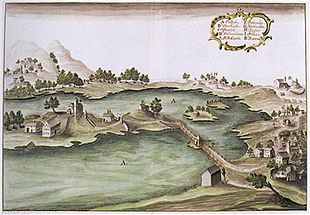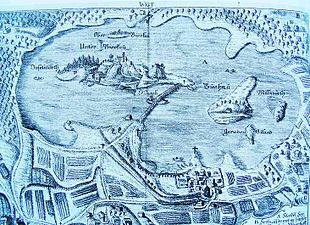Wörth (Staffelsee)
| Wörth | ||
|---|---|---|
| The Staffelsee (Wörth is to the left of the center) | ||
| Waters | Staffelsee | |
| Archipelago | 7 islands | |
| Geographical location | 47 ° 41 '5 " N , 11 ° 9' 55" E | |
|
|
||
| length | 1.2 km | |
| width | 650 m | |
| surface | 39.512 ha | |
| Highest elevation | 680 m above sea level NHN | |
| Residents | 5 13 inhabitants / km² |
|
| main place | Wörth | |
|
Map of the Staffelsee
Jakobsinsel to the island of Wörth |
||

The island of Wörth is the largest and only permanently inhabited island in the Staffelsee , with an area of 39.5 ha (395,120 m² to be precise) and a population of around five people.
geography
Wörth is also the name of the corresponding smallest district of the municipality Seehausen am Staffelsee , to which the island belongs. The island is used for agriculture . The pastoral economy ( cattle ) was abandoned in 2005 by island farmers for reasons of age and will not be continued by the successor tenant. Therefore, in December 2005 a herd of nine was rear cattle for landscape maintenance (as "natural lawn mowers") brought a ferry to the island, the 36 hectares of forest and pastures (16 ha of pasture, 14 hectares of forest, 6 hectares of forest and hay meadow) to keep from becoming overgrown. The animals live freely all year round on the island. An electric fence with a voltage of 8,000 volts is supposed to prevent them from going out onto the frozen lake in winter. The herd should grow to a maximum of 20 animals.
The highest point measures 682 m above sea level. NN (33 m above the lake level). On the island there is a farm building ( farm buildings , inhabited by a family), a mansion or manor ( castle , from the Bavarian palaces and lakes management privately leased, occupied by a caretaker couple) and in 1838 by Joseph Utzschneider to replace the abandoned monastery church donated Simpertkapelle (St. Bonifatius), which was reopened in autumn 1999 after extensive renovation work and where regular services have taken place since then. All three buildings are listed . The chapel is also very popular for weddings or for baptisms of residents of Seehausen.
The island of Wörth is approached by the MS Seehausen for groups of 20 people or more from the Seehausen pier (north bank of the Burg peninsula) . Crossings are only possible by prior arrangement or reservation. The crossing leads south past the Jakobsinsel. The distance is only around 600 meters.
The Linderhof Palace and Garden Administration is responsible for administration and maintenance .
history
As far back as the late Bronze Age in the 2nd century BC, the protective location of the island of Wörth was demonstrably sought. However, it was only the Romans in the 4th and 5th centuries AD that left clear traces . Remains of a protective wall to ward off the Germanic peoples testify to a rural settlement on the island. The first structures on the mainland were probably built at the same time.
In the 7th century a Bavarian nobleman built a courtyard on the island with a small chapel. This was destroyed with the construction of the Carolingian monastery in the 8th century. Preserved inventory ( Staffelsee inventory ) testifies to the rich furnishings of the monastery . From then on, the farmers on the mainland were subject to this Staffelsee monastery .
In the 11th century the monastery was dissolved and the monastery church became the parish church for ten places in the vicinity. In order to be able to reach the church on the island without a boat, a wooden walkway was built from the mainland from Seehausen via St. Jakob (Jakobsinsel, the smallest of the seven Staffelsee islands) to the island of Wörth, as a picture from 1770 clearly shows. The pier posts are still visible under water. Freshwater sponges have settled on them (see below).
The Staffelsee came to Ettal Abbey in 1330 through a gift from Emperor Ludwig of Bavaria . The Seehauser fishermen and most of the farmers in Seehausen were now subject to the Murnau court of the monastery until secularization in 1803 .
In 1773 the island parish church with its remarkable baroque furnishings was transferred to the village of Seehausen after the path over the footbridge was considered difficult and the footbridge broke from the storm .
In 1935 the tradition was established to carry out the Corpus Christi procession from Seehausen ( St. Michael parish church ) to the island of Wörth (Simpert Chapel) with boats and barges decorated with flowers.
At the end of September 2005 an archaeological park was opened around the chapel with information boards about the two thousand year history of the island, which show the walls and enclosures of the former early churches, the monastery and the parish church. Archaeological excavations have shown that it was inhabited by humans a long time ago. There are already traces from Roman times. In the 8th century the Staffelsee Monastery was founded , which was dissolved in the 11th century.
ecology
In the summer of 2003, the freshwater sponge Spongilla lacustris was discovered on the old pier posts , which is rarely found in Europe. In specialist books, the species is never listed larger than 30 cm, but in the Staffelsee it is more than the size of a man.
literature
- Brigitte Haas-Gebhard: Archaeological excavations on the island of Wörth in the Staffelsee. In: Dedicatio. Hermann Dannheimer's 70th birthday (= catalogs of the Prehistoric State Collection. Supplement 5). Michael Lassleben, Kallmünz (Opf.) 1999, pp. 140-161.
Individual evidence
- ↑ Aurochs on the island of Wörth ( Memento of the original from May 11, 2015 in the Internet Archive ) Info: The archive link was automatically inserted and not yet checked. Please check the original and archive link according to the instructions and then remove this notice.
- ↑ The aurochs project on the island of Wörth ( memento from November 10, 2011 in the Internet Archive ), broadcast by Bayerischer Rundfunk on August 5, 2011, mp3, approx. 28 min.
- ^ Seehausen am Staffelsee: history
- ^ Stanislaus Aloysius Kaiser: Description of the translocation of the parish church from Staffelsee to Seehausen. 1773, p. 18.
- ↑ Portrait: Local rarities. Original, soft and tough. BUND magazin [1-03 ( Memento of the original from March 11, 2012 in the Internet Archive ) Info: The archive link was inserted automatically and has not yet been checked. Please check the original and archive link according to the instructions and then remove this notice. , Page 40] (PDF; 1.2 MB)
- ^ Bavarian State Ministry for Environment and Health: Environmental object catalog: Spongilla lacustris - Staffelsee
- ↑ Staffelseeschifffahrt: freshwater sponge





